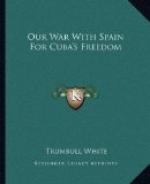“Theirs not to
reason why,
Theirs but to
do and die.”
About the rough riders.
Those who are acquainted with the nature of the service usually required of cavalry in time of war will not question the usefulness of the cowboy regiment—rough riders as they are called—that were raised in the West to take part in the invasion of Cuba.
The cowboy is a rapidly passing type. Barbed wire, the fencing in of the range, together with the irrigation and cultivation of those regions which were once marked as deserts on the maps—have been responsible for his undoing and he has made what may prove to be his last stand, as a soldier.
The cowboy regiment was the idea of the assistant secretary of the navy, Theodore Roosevelt, who had had some experience himself as a cowboy on his Wyoming ranch and who was an expert in such matters as branding, rope-throwing, broncho breaking and those other practices which are peculiar to the “cow-puncher.”
Lieutenant-Colonel Roosevelt’s regiment, which figures on the army records as the “1st regiment of rifle rangers,” but which the general public from the first preferred to call “Roosevelt’s rough riders,” or more simply still, “Teddy’s terrors,” was made up almost entirely of cowboys, with a small sprinkling of society men, who had both a fondness and an aptitude for horsemanship, which had found no other outlet than that offered by the hunting field and the polo ground.
Made up almost entirely of cowboys.
In organization the regiment was not widely different from the famous Texas Rangers, but the uniform was the same as that of the cavalrymen of the regular army, slightly modified. Its personnel, with the exception of the millionaire members—was about the same, however, as that of the Rangers. It included men from almost every State in the Union, and they could one and all ride well, and shoot well, and many of them smelled powder in more than one Indian war.
While Lieutenant-Colonel Roosevelt took the most active part in its formation, he did not command the regiment. That responsibility was delegated to Colonel Wood, who was almost as well known in the West as Roosevelt was in the East. He entered the army as a surgeon, but he probably had much more to do with the making of wounds than their healing.
It is said of him that when he was first assigned for duty to an Arizona post he arrived at the post one night at 7 o’clock, and the next morning at 4 was in the field and at work. This was during the Apache campaign in 1885, and Surgeon Wood soon won for himself the name of the fighting doctor. He was conspicuous in the famous Geronimo outbreak, having command at various times of the infantry and scouts engaged in the chase after that wily savage.




